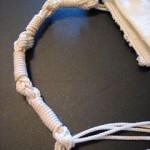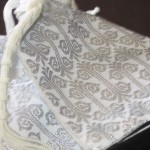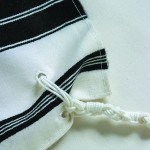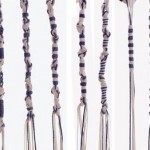What is the most important part of a tallit? The tzitzit, of course, which are really the tallit’s raison d’être. Without the tzitzit the tallit would be just a nice wool shawl for men. Yet some people don’t think twice about the tzitzit when buying a tallit.
Whether you plan to tie the tzitzit yourself or buy a tallit with pre-tied tzitzit, you’ll want to know the basics before you get started.
Ashkenazi tzitzit custom – The default option
 There are several different customs followed for tying the knots and coils. The most prevalent, by far, is the Ashkenazi custom of five double knots with coils in between (7, 8, 11 and 13 coils respectively). This is the default option on just about any tallit sold with tzitzit already tied, though many sellers are able to accommodate special requests. (At Ben’s Tallit Shop, we’re set up to tie Ashkenazi, Sephardic, Yemenite, Chabad and more.)
There are several different customs followed for tying the knots and coils. The most prevalent, by far, is the Ashkenazi custom of five double knots with coils in between (7, 8, 11 and 13 coils respectively). This is the default option on just about any tallit sold with tzitzit already tied, though many sellers are able to accommodate special requests. (At Ben’s Tallit Shop, we’re set up to tie Ashkenazi, Sephardic, Yemenite, Chabad and more.)
Sephardic tzitzit custom – The one-coil chulya
Sephardic Jews add a special loop around each coil, known as a chulya. Once you learn how to do the loops, this method of tying is not hard at all. They generally make 10, 5, 6 and 5 coils respectively, hinting at the Tetragrammaton, whose letters in Gematria are 10, 5, 6 and 5. Many Sephardim follow the 7-8-11-13 pattern for their tallit katan.
The Yemenite tzitzit custom: The Rambam’s chulyoth

A significant portion of Yemenite Jews follow the halachic rulings of the Rambam (Maimonides), who prescribed a unique method of tying tzitzits. To be honest, I had watch two videos and consult with three different “tutors” before I was able to do the special knot, which is quite counterintuitive.
Each knot has three coils (forming a chulya) that stay in place without any double knots. Either 7 or 13 chulyas are made, depending on the custom followed.
Chabad tzitzit tying custom: Typical Chabad innovativeness

Finally is the Chabad tzitzit tying custom. It starts with a very innovative technique of looping the shamash through an extra hole in the tallit to keep the tzitzit from working their way around to the wrong side of the tallit. Then chulyos are made, with varying numbers of coils in each chulya.
The first section has three chulyos of 3, 3 and 1 coils respectively. The second section has three chulyos of 2, 3 and 3 coils respectively. The third section has four chulyos of 3, 3, 3 and 2 coils respectively. And the fourth section has five chulyos of 1, 3, 3, 3 and 3 coils respectively.
Tzitzit: Thick or thin?

Whether you opt for thick or thin tzitzit is primarily a matter of aesthetics and personal choice. Thick tzitzits are very rare on a tallit katan, but in the case of a tallit gadol, you can go either way. Very modern tallits always come with thin (usually machine-spun) tzitzit, but in traditional Orthodox congregations, thick tzitzit are the norm. Among the Modern Orthodox, you will see both, although thick tzitzit are probably more common.
Techelet
Techelet is a whole different ballgame. There are at least eight different ways to tie the strings. When customers ask me to tie techelet tzitzit for them, I recommend the Vilna Gaon’s technique because in my opinion it is the most straightforward and easiest to understand in terms of the essential requirements described in the Gemara and Rishonim, namely 7 to 13 chulyos starting and ending with white, separated by five knots.

